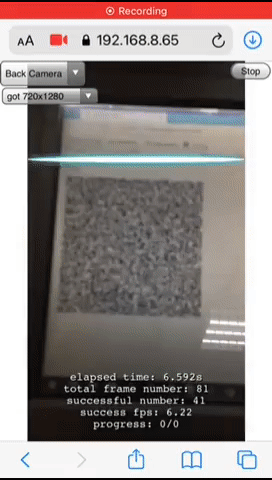QR codes are essential in the modern world, enabling quick and efficient access to information, online payments, and interactions with various services. These barcodes are widely used for billing, warehouse management, hospital management, and more.
To meet the growing reliance on this system, barcode scanners must become more sophisticated and offer a range of features to enhance their accuracy and reliability.

7 Effective Ways to Achieve QR Code Accuracy and Reliability:
1. The Use of Reticle or Viewfinder
One of the simplest yet most effective tools for improving scanning accuracy is the reticle or viewfinder. When scanning a QR code, a reticle or frame appears on the scanner's screen, indicating active scanning and providing precise guidance on where to position the QR code.
Ensuring the QR code fits neatly within the reticle's boundaries guarantees that the entire code is read without missing any part. This practice enhances the accuracy and reliability of the scanning process, whether using a dedicated scanner or a mobile app.
2. Module Partitioning and Identification for Enhanced Accuracy
Modern QR code scanners are equipped with advanced features beyond basic scanning, such as module partition and module identification. Module partition overcomes the negative effects of perspective and border errors by intelligently partitioning the code's modules. Module identification identifies each module using discriminative features, making it easier to decode intricate QR codes. These features enhance the scanner's ability to read complex QR codes accurately.
3. Error Correction
QR codes are designed to be damage-resistant. They incorporate Reed–Solomon error correction, ensuring that even if a QR code is damaged, it can still be read. Users can select the desired error correction level when generating QR codes: Low, Medium, High, or Quartile. Opting for the highest correction level, which can restore up to 30% of data, makes QR codes a robust choice for applications where error prevention is critical in increasing their accuracy and reliability.
4. Auto Deskewing for Crumpled Codes
Crumpled or distorted QR codes are common, especially when printed on plastic packaging, cylinder containers, paper receipts, or tickets. These codes can pose a challenge for accurate barcode recognition. Advanced barcode reader SDKs employ pre-processing features to auto-deskew barcodes, maximizing their recognition accuracy.
Using finder patterns, timing patterns, and alignment patterns helps reduce errors during the contour line connection process. By perspective-transforming each symbol onto a standard grid, it is possible to obtain a corrected QR code, ensuring precise decoding.
5. AI Integration
AI integration significantly improves QR code scanning by employing adaptive algorithms that fine-tune scanning parameters based on the specific QR code being scanned. These algorithms dynamically adjust scanning speed, resolution, and focus settings to capture a clear image, ensuring optimal performance even in challenging conditions.
By learning from a large dataset of QR codes, AI algorithms can enhance their scanning accuracy. Machine learning techniques train these algorithms on diverse QR code samples, enabling them to recognize patterns, variations, and potential challenges. This learning process equips AI with the ability to generalize and adapt to different types of QR codes, thereby improving accuracy.
Additionally, AI-powered Natural Language Processing (NLP) algorithms can analyze the textual information within QR codes. Techniques, like named entity recognition, part-of-speech tagging, and sentiment analysis, can extract meaningful information such as names, dates, locations, and sentiments, enabling deeper insights and more targeted interactions based on the extracted data.
6. Using an Advanced Barcode Scanner SDK
An advanced barcode reader SDK enhances the accuracy and reliability of QR code scanning by utilizing robust, enterprise-grade barcode detection algorithms. These algorithms excel in challenging conditions, such as scanning multiple barcodes simultaneously, reading barcodes on curved surfaces or in motion, and detecting high-density barcodes.
They also perform well in low light, with shadows, glare reflections, skewed angles, and even blurred or inverted color barcodes. Such SDKs are capable of reading barcodes from long distances and with low-resolution cameras. This versatility ensures that QR codes are reliably detected and scanned, regardless of the environment or condition.
7. Precise Testing
Precise testing is essential to ensure the reliability of QR codes. This process involves several crucial steps:
First, QR codes are scanned from various distances and under different lighting conditions to ensure readability in real-world scenarios.
Next, the codes are tested across diverse devices, considering the wide array of smartphones, tablets, and scanning apps in use. Compatibility across platforms and browsers is also assessed to ensure seamless accessibility.
Using a stable internet connection at the point of use is imperative, particularly for QR codes linking to online content.
Meticulous attention is paid to the accuracy of embedded data to prevent misinformation or confusion. This comprehensive testing process ensures that QR codes function reliably and accurately in any situation.
Conclusion
In conclusion, the accuracy and reliability of QR code scanners can be significantly enhanced using the above techniques. Whether you're a business or an individual, the above ways can help you achieve more accurate and reliable QR code scans, facilitating smoother interactions even in the case of a damaged QR code.